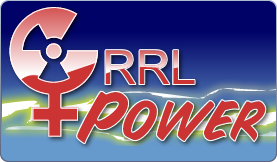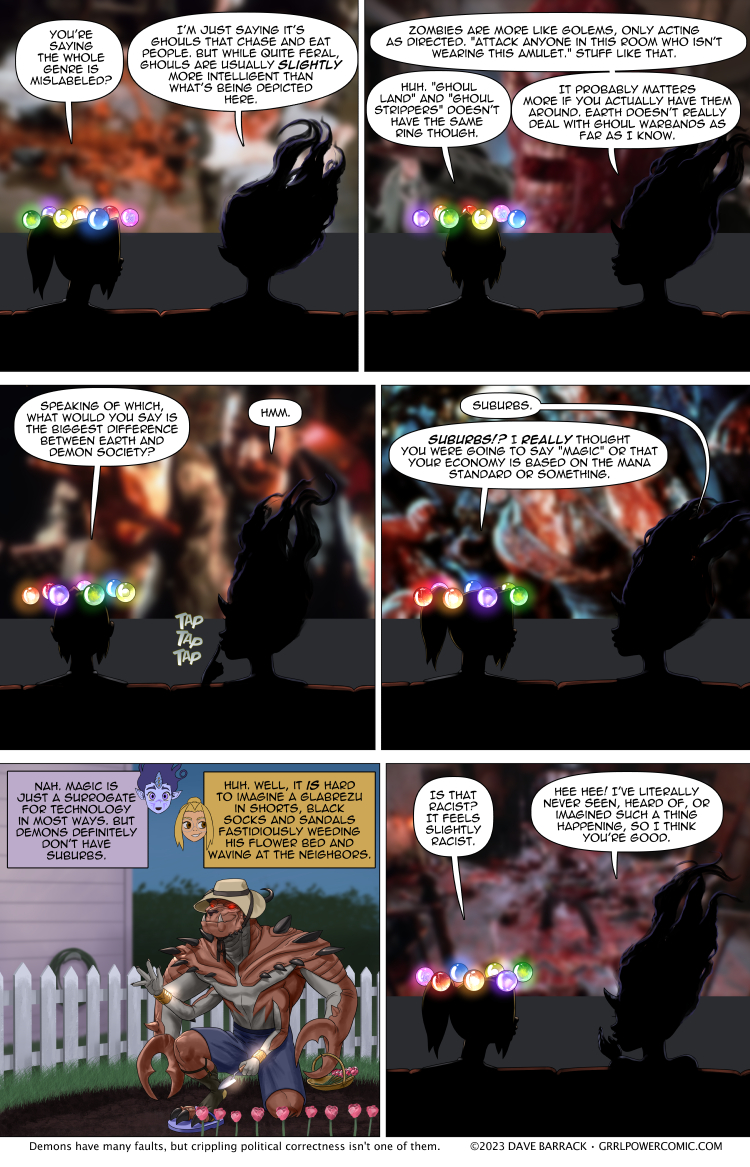Grrl Power #1186 – MSTGP
Did you know that in the original Night of the Living Dead, they never use the word Zombie. They do, however, use the word Ghoul. At least, it’s said in one of the news reports. The people in the house just call the undead “those things.” It kind of bugs me that the whole genre is mislabeled, but to Sydney’s point, “Zombie” is just a better word than “Ghoul.” It was suggested in the comments that ghasts are the kind of zombies that appear in iZombie/Santa Clarita, and if they don’t get enough brains they devolve to ghouls. I couldn’t find much to support that, and D&D certainly has different ideas about ghasts, but I support the idea that the iZombie type of undead needs an agreed upon moniker.
Demon society superficially resembles something in between medieval Europe and post-apocalyptic movies. Lots of keeps and castles adorned with spikes and skulls, city states run by the baddest dude, that sort of thing. But modern demon society is actually pretty good about inter-state commerce, modern amenities, and internet-like communications. Don’t forget they’re a star faring race. They just prefer a very dire aesthetic, and keep things like satellite dishes either out of site or decorate them so they look like they’re made of bones and peeled skin. Want to get rich? Take over the contact paper industry on Infernum.
So I did rewatch Return of the Living Dead 1, 2 and 3. 1 was by far the best. Coincidentally it also had full frontal Linnea Quigley in it. If you don’t know who she is, basically she’s an 80’s scream queen who practically spent more of her screen time nude than not. LD 2 was really a waste of time. LD 3 wasn’t great, but at least it wasn’t virtually a remake of 1 minus the nudity like 2 was. I also watched Return of the Living Dead: Rave to the Grave. It was… fine, I guess. I also watched Creepozoids, also starring Quigley. It was pretty dull. Then I watched Vamp, starring Grace Jones painted like a Zebra. It was okay. Just a “People go to place, discover vampires are a thing, people die, vampires die, the end.” flick. I also watched The Phantom Empire. I know that sounds like a Chinese Star Wars knock off, but it was a horrible, boring Roger Corman flick and I didn’t finish it. Then there was Peelers, your basic zombies vs. strippers flick. As those sorts of movies go, not too bad. I would hardly recommend it, unless you’re exactly in the mood for some gore and toplessness of moderate frequency. At some point I watched Night of the Creeps. Your basic “alien slugs turn people into zombies whose heads explode and release more slugs” movie. Honestly, it was one of the best ones of the bunch. Probably tied with RotLD1.
Though if you want the best alien slug movie, you’ve got to go with Slither. I mean, it’s got Nathan Fillion, Elizabeth Banks, Michael Rooker, and was directed by James Gunn. If I had to pick a #2 alien slug movie, it’d be The Faculty.
I also watched (look, I watch and listen to a lot of stuff while I draw.) Slave Girls from Beyond Infinity. Actually, not too bad. Not good, certainly, but better than most of the stuff I watched since Monday. A barely Sci-fi version of The Most Dangerous Game starring blonde chicks in feathered 80’s hair and bikinis.
The July vote incentive is finally up! There was a disagreement about digitigrade and plantigrade leg configurations. What better way to resolve it than a race?
And in the Patreon variant, what better way to resolve it than a nude race? You know, to eliminate uh… wind drag I guess?
.
.
Double res version will be posted over at Patreon. Feel free to contribute as much as you like.

















For a long time I didn’t understand how the USA ever came to their car and free standing home obsession and most importantly hate to all public transport.
Than I learned American history.
Now I think I understand:
Once upon a time the railway companies ruled the USA. They build railways from one hub to another and opened cities in between.
They made these cities viable by stopping there and profited from it by selling the land.
In these cities and basically the whole USA they had a close to absolute monopoly on external transport, which allowed for abuse of power and as such they did a lot.
Half American history is filled with railway companies harassing workers rights, creating new monopolies, bribing politicians and generally hurting citizens.
Than the car came. Suddenly individuals controlled large distance transport. Monopolistic action in the market could be punished and it did. They killed the railway companies and spread even further through the USA. This also gave power to a different group road builders, because although roads are less efficient than railways they’re the only form of transport they trust.
Why didn’t this happen in Europe:
a. higher population density during the introduction of the train making trains harder(basically requires government mandates and ground costs) and less effective(smaller travel distance).
b. stronger more mature government control
c. existing road structure.
d. less experimental population(if you just arrive in a country you care less where in the country you’re going to live and tend to take the cheapest route)
Another important point about the car and roadways replacing the railroads – even before the Great Depression, and continuing after WWII with a major expansion in the 50s, the interstate highway system was built primarily to stimulate the economy by providing jobs and moving more goods. The Federal government poured insane amounts of money into roads and bridges, especially post-depression in connection with the Public Works Administration – roads accounted for 1/3 of PWA projects.
And yes, there was also the social goal of breaking up the conditions for robber baron monopolies that had given the railroads so much power and contributed to the economic needs of the masses. Both rail and road were deliberately accelerated with massive federal subsidies to get American territory populated and producing from its natural resources (more farming and mining especially). And it worked, the US became one of the largest economies in the world.
But capitalistic concerns aside, rail was and is still the most energy efficient way to move people and goods – could this expansion have been accomplished via rail if the monopolies were broken down? Probably an interesting argument there, given the railroads had been built for the same reasons, expansion and jobs. But – America didn’t need logistics efficiency or more cross-continental activity during the early and mid 1900s, those already existed. It needed the opposite – huge amounts of local jobs and spending, and roadway projects are really, really good vessels for both. Especially since the roads (and other projects) were selected and owned by the state governments instead of private businesses, which improved the project selection criteria and long-term value, but just as importantly ensured that the funds to build and maintain the roads kept circulating publicly at the state level instead of being sucked into megacorporations.
Once the automobile became big business the major companies weren’t much better. Henry Ford could hold his own with any of the railroad barons. The battles between the various car companies could make feudal kings blush. I suppose that the outcome is still the same and in the bigger picture of history a single lifetime is sudden but it really took about 50 years to make the shift from automobiles to railroads. It didn’t happen all at once across the country. The east coast had more established roads prior to the railroads becoming common while in the center of the country. There were many places where there just weren’t any roads as such, even after the onset of the automobile. My parents’ families didn’t have regular access to an automobile until just before WWII and any trip over 25 or 30 miles was a major event. Even a trip from my home town to the county seat was easier by train than by auto. The central US is also dotted with place names that mark the location of railroad spurs that were a necessity for agriculture. There is a limit to how far you can practically haul wheat or cotton with a horse drawn wagon or Model T truck. You could argue that WWII helped to kill the railroad system. The war lead to increased manufacturing capacity that could be applied post war. Trucks became bigger and more efficient and in the Eisenhower era we saw the beginnings of the coast to coast interstate highway system. A highway system that was inspired at least in part by the German Autobahn. There is an aspect of marketing. Postwar cars were sold not just as transportation but as a status symbol and a sign of prosperity. The suburbs discussed in many other posts also could be seen as a part of this marketing campaign. A house with a yard and a shining car our front was just a part of the package that was sold as the American Dream. Relating to roads being less efficient, I’ve noticed especially around the Dallas, Ft. Worth area that the suburbs are growing fast enough to outstrip the capacity of the road system. It reminds my of playing Sim city back in the 90’s sometimes you ended up with more road than city just to keep things running.
Interesting comments, maybe I can contribute a few points.
Speaking as an American (not a “USAnian” or whatever), I do not hate public transport, aka mass transit. I have used it when I needed to. The freedom obtained with a car and driver’s license especially appeals to young people. This is a kind of genie that can’t be easily coaxed back into a bottle. And if you put wings and jet engines on a bus, how is it still not mass transit?
Re: the railroads and the government, I’ve read that one of the issues during the 1860 election was “internal improvements”. At that time the federal gov’t did not exercise the kind of authority to coerce the states into interstate projects that it acquired as a consequence of the Civil War. My source did not define the improvements in question, but it probably included railroads, canals, etc. It seems to me that they were arguing over ways to allow the federal gov’t to assist in such projects, without allowing it out of its’ Constitutional box. Then events overtook that issue.
Re: The Interstate highway system being inspired by the German Autobahns, that is correct. Remember that President Eisenhower, formerly the Supreme Commander of the western Allied Expeditionary Forces, got a good look at how handy an Autobahn was for moving military forces. So the initial purpose of the interstates was to allow the U.S. Army to easily move “from sea to shining sea”. Many features of the Interstate system were designed for military use. Economics of course came into play, but that was tacked onto the concept later.
In my teens I rode with a friend & his family on a freeway trip, and we passed a shopping mall that had no exit nearby to reach it easily. When I asked “why not?”, the father replied “somebody didn’t line the right pockets!”. If humans were angels we wouldn’t need government.
The term ‘USAsian’ is to differentiate other North (and South) Americans from those from the un-United States, specially the ones who unfortunately have to share the North :P
To be fair, our other options are pretty bad.
Hay guise,
great fun as always with Dynotaku’s^W Dave Barrack’s artwork :-)
> They just prefer a very dire aesthetic, and keep things like satellite dishes either out of site or decorate them so they look like
did you mean “out of sight”?
Yeah, or they used a german one with “SatAn” printed in large friendly letters on the dish – I dunno who at Kathrein thought of that name (an abbrev. for SATelliten-ANtenne, probably) but I love ’em for that. The presbyterian neighbours sputtering about that “unchristian thing” on my roof are soooo much fun to tease: “Which unchristian thing do you mean? The one I did last night?”
I mean… most countries don’t have suburbs either. It’s a genuinely USAnian thing.
Nah, not just USAsian, just… not European
Haven’t seen many at all in South America either, or most of Asia, or Africa… Seen a couple in Dubai.
Maybe just a British Empire thing?
Ah, they call them favelas, barriadas, chabolas, tugurios, arrabales, and… suburbios.
Banlieue in French
In England just “suburbs”
Very Russian thing too, along with entire eastern Europe. We just don’t live there generally, it’s usually our summer houses for weekends. But I personally do live in the countryside! and yeah, there’s almost no public transport, it’s a thing for big cities and to get to/from the countryside villages. For the last mile (1-5 km) you’re usually on your own.
As far as zombies versus ghouls … I’m surprised Sydney didn’t bring up the Fallout take on them. Ghouls there are heavily irradiated humans who themselves are healed by radiation and come in two main flavours. Normal ghouls are just people. Feral ghouls will eat your face. I remember Jason Bright in New Vegas was trying to take some ferals with him to the Far Beyond or Great Beyond, I forget which. (Do the quest right and some come back to help a nearby town post-finale.)
This little town is made up of at least ten ‘suburbs’ (population is only between 50 or 60 thousand… )
Was re-watching The Mummy remake (the one with Fraser), and the victims of the boils could be described as being zombies being controlled by Imhotep
Grrlpower seems to operate on “it ain’t racism if all stereotypes are universally true” logic. Making jokes about it often only to be told that the stereotype being false is literally unthinkable.
I would totally read a side comic of these two, and occasional others, watching random stuff and making comments MST 3000 style.
As far as ’80s scream queens go, I always preferred Michelle Bauer over Linnea Quigley.
Suburb demons… we call them Karrens.